Advertisement
No GPS? No autopilot? No computer? The 50th anniversary of the Golden Globe Race, with its rules banning all modern technology, attracts a new group of adventure-seekers.
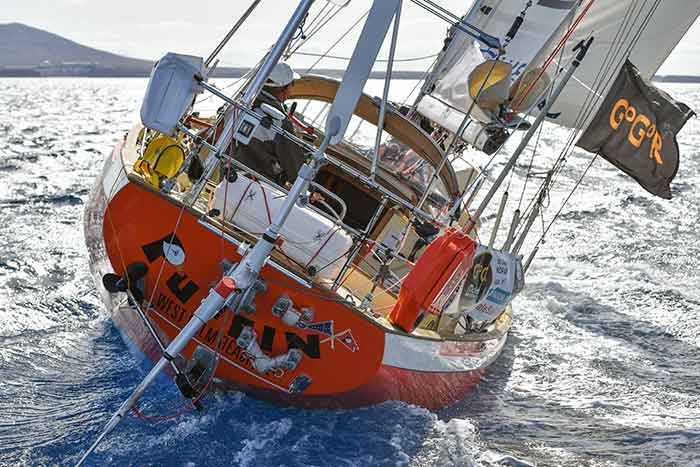
BoatUS member Istvan Kopar was on track to finish in mid-March. (Photo: Christophe Favreau/PPL/GGR)
"I'd just had my 60th birthday." Istvan Kopar said. "At this age you feel your time frame narrowing down." Kopar, a BoatUS member, decided to mark the occasion. But rather than buying a sports car or tinkering on a 1980s Scarab, he bought an old boat and entered one of the most challenging and arguably dangerous boat races in the world.
The 30,000-mile, 200-plus-day solo Golden Globe Race (GGR) limits competitors to using only 1960s technology — what was available to the sailors during the first Golden Globe 50 years ago. The long list of banned items includes GPS, autopilot, modern weather routing, and computers. The race is so challenging that only one of nine boats completed the first Golden Globe in 1968. To truly appreciate the challenge and why anyone would undertake it, let's look back at the race's extraordinary history.
The 1968 Golden Globe Race
In 1967, British sailor Francis Chichester, a businessman in mining and real estate, made the first-ever solo one-stop circumnavigation and was celebrated on newspaper front pages around the world. But even as he sailed back to port, the media began asking, "Who will be the first to do it nonstop?" Imaginations were lit, and several sailors began preparations.

Robin Knox-Johnston (standing), winner of the 1968 race with Suhaili. (Photo: Fiona McGlynn)
Among them was 29-year-old Robin Knox-Johnston. After serving in the British Merchant Navy and Royal Naval Reserve, Knox-Johnston built a 32-foot ketch, Suhaili, in India and approached Chichester's sponsors, The Sunday Times newspaper, for financial backing. The Times, having profited from Chichester's success, was interested, but with several other promising competitors concluded that Knox-Johnston, in his small boat, was the least likely to succeed. They decided to sponsor a race instead. In March 1968, The Sunday Times Golden Globe Race was announced, with a prize for the fastest-time of £5,000 (equivalent to £82,500 or $105,000 today).
Frenchman Bernard Moitessier was planning a circumnavigation anyway, and at first was uneasy when The Times invited him to join their race, worrying that this commercialization violated the spiritual principles that had inspired his journey. An experienced sailor, he finally joined and became the immediate favorite to win the speed record.
Then, there was British amateur sailor Donald Crowhurst, father of four, who owned a small struggling electronics business. An inventor and dreamer, Crowhurst mortgaged his business and home to build an innovative but unproven trimaran. Early in the race his boat suffered numerous breakages. Facing potential financial ruin if he quit, he began falsifying position reports while bobbing in the Atlantic, showing himself steadily sailing around the world, always well behind the leaders. Then, disaster. Moitessier, approaching the end of the race in first place took the world by surprise when he fired a note by slingshot onto a passing container ship declaring that he was quitting "to save my soul" and continued sailing, making a near second lap of the world. Next, other leaders had catastrophic problems, one by one dropping out.
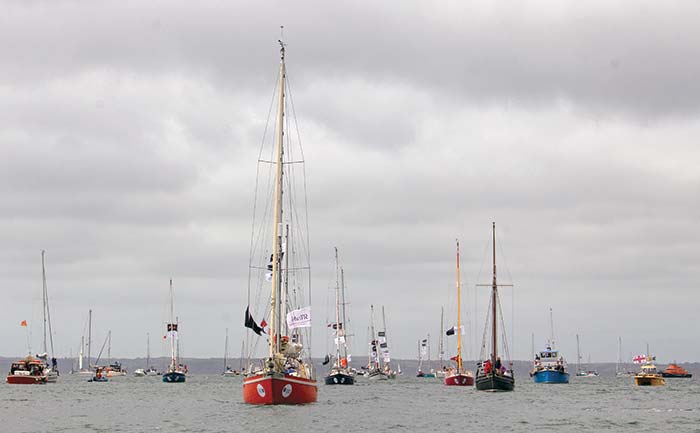
Photo: Fiona McGlynn
Out of nowhere Crowhurst, the unassuming electrician, became the perceived "front runner." The public went wild. Crowhurst's deception and suddenly imminent exposure drove him mad, and he committed suicide at sea. His story became one of the great sailing books of all time, The Strange Last Voyage of Donald Crowhurst, recently made into a film, "The Mercy," starring Colin Firth.
To everyone's great surprise, the man least expected to succeed, Knox-Johnston, was the only person to finish the race, and won it. After 312 days at sea, the previously unknown 30-year-old arrived in Falmouth on April 22, 1969, to cheering crowds of thousands. He donated the £5,000 prize to the Crowhurst Appeal Fund and became a national hero.
Moitessier's legend also grew. He became something of a mystic, completing a near second circumnavigation, setting the record for the longest nonstop passage by a yacht, before stopping in Tahiti. His best-selling book, The Long Way, has been translated into many languages and inspired generations of sailors to go to sea. Thanks to Moitessier, sailing was no longer just for the elite; it was for adventurers wanting to satisfy a spiritual quest and discover their true selves.
A Retro Race
It would be 50 years before the Golden Globe ran again. In the interim, man landed on the moon, the U.S. military invented the Global Positioning System (GPS), computing dramatically improved weather forecasting, and Iridium and Globalstar launched their first satellites. Other technologies also became widely available to boaters — solar power, desalination (watermakers), electronic autopilots, fishfinders, personal computers, mobile phones, and of course the internet. If you'd given Bernard Moitessier an Iridium Go in 1968 and told him he could update his Facebook page (if it existed) in the middle of the Pacific, he might never have returned.
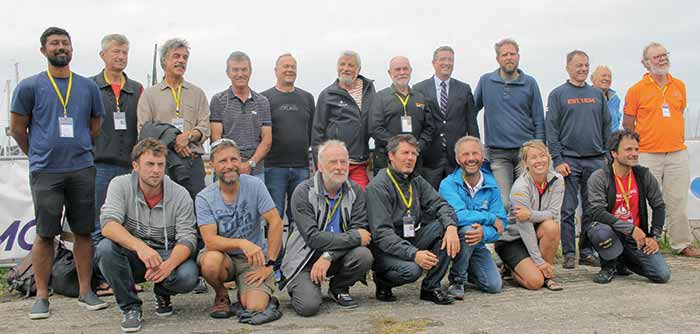
The 17 starters of the 2018 Golden Globe Race. (Photo: Fiona McGlynn)
Extraordinary advances in technology compressed timelines and amped up the ambitions of modern-day adventurers. What took Knox-Johnston 312 days, 50 years ago, was accomplished in 2017 by French sailor François Gabart in just 42 days — that's seven times faster! We now know it's possible to sail around the world solo nonstop in just over a month! So when the 2018 GGR was announced, it was clear that it was not about breaking records. It would be a retro experiment to see how much technology is responsible for human accomplishments in modern boating. Would more skippers complete the race this time around? The 2018 GGR racers were about to find out.
The Retro Racers
The 2018 GGR competitors who set sail from Les Sables D'Olonne, France, in July 2018 were a colorful cast, ranging in age from 28 to 73 and including a mountaineer, oceanographic surveyor, foreign-exchange trader, and rower who holds the speed record for an Atlantic crossing. The latter, 41-year-old Mark Slats pulled ahead early in the race by rowing his 36-footer in low winds; he could average 2 knots in a dead calm. Turning 29 during the race, Susie Goodall was both the youngest and only female competitor. Before entering the race, she worked as an offshore sailing instructor and professional skipper, and was the only competitor to receive significant sponsorship from worldwide courier DHL.
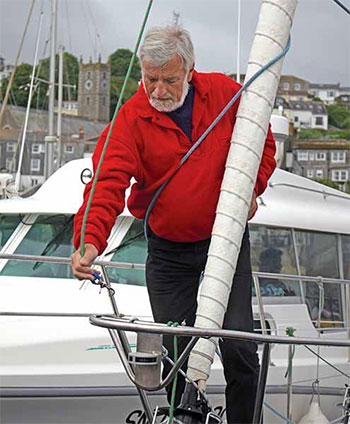
Jean-Luc Van Den Heede of France was the first to cross the
finish line on January 29, just under 212 days from the race
start. (Photo: Fiona McGlynn)
The oldest racer, Jean-Luc Van Den Heede (73), is living proof that it's never too late to follow your dreams. The five-time circumnavigator and father figure in French solo sailing is just four years younger than his good friend Sir Robin Knox-Johnston. Mark Sinclair (60) was 10 years old when Knox-Johnston departed to sail around the world. When Sinclair, a professional hydrographic surveyor who served 20 years in the Royal Australian Navy, learned of the 2018 GGR, he bought Coconut, a Lello 34, and was quickly nicknamed "Captain Coconut" by fellow skippers for his cheerful demeanor.
Of the four Americans originally entered in the race, two made it to the start: Istvan Kopar (65) and Nabil Amra (43), two men with very different backgrounds. Kopar spent the last 50 years working as a naval officer, merchant marine, commercial captain, and U.S. Sailing instructor. He's logged more than 60,000 miles solo and set a speed record for a west-about circumnavigation in 1990/91.
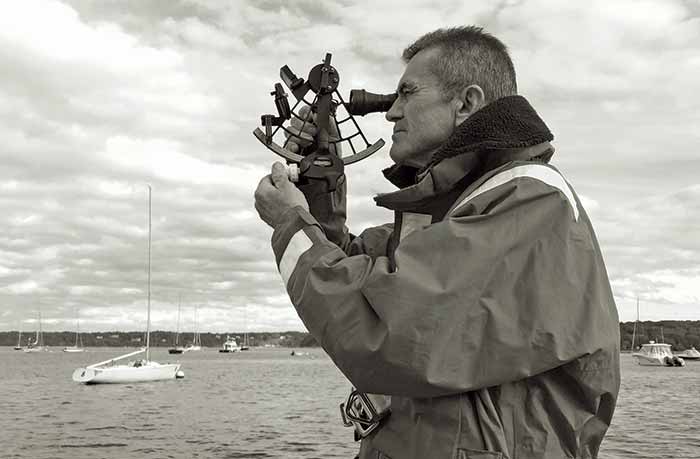
Kopar brushes up on his celestial navigation. At the time this article was published, he was on track to finish fourth. (Photo: Fiona McGlynn)
Amra, an amateur sailor, worked as a foreign-exchange trader in Minneapolis, Minnesota. One day on a lunch break, reading magazines at the Barnes & Noble across from work, he saw an article about the 2018 GGR. Inspired, he returned to the office and signed up on the spot. The Palestinian-American raced under the Palestinian flag. "I'm starting a new chapter in my life that has more to do with adventure," he said.
Old-School Boats
According to the 2018 GGR race rules, all entries had to be production boats between 32 and 36 feet, designed prior to 1988. The list of race-approved boats included the Westsail 32, Baba 35, and Cape Dory 36 among other familiar makes. In refitting, competitors focused on reinforcing and strengthening (e.g., adding new rigging, replacing the mast) but weren't allowed to strip boats for speed. Unlike the $10- to $15-million-dollar entries in modern sailing races like the Vendée Globe, preparations for the 2018 GGR were a modest affair, costing between $200,000 and $300,000 to purchase and refit a boat.
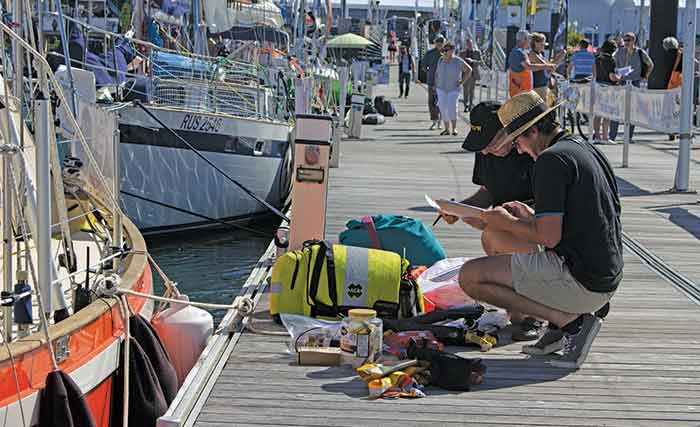
A GGR official reviews Kopar's emergency equipment before the start of the race. (Photo: Fiona McGlynn)
More affordable perhaps, but easy? No. Kopar spent more than 2,000 man hours, and he and his wife spent $100,000, preparing his 1975 Tradewind 35, Puffin. They sold and downsized their home to fund it and spent much of the last two years apart while Kopar prepared the boat in New York.
1960s Technology
The competitors were limited to using only technology available on Knox-Johnston's boat when he won the first Golden Globe in 1969. Skippers removed anachronistic systems like chartplotters, electronic autopilots, electronic boat-speed indicators, and digital clocks, and added their retro equivalents: sextants, windvanes, trailing logs, chronometers. All modern safety equipment that would provide a competitive advantage had to be stored in a sealed container. Breaking the seal meant disqualification.
Not only the boating technology had to be retro, also everyday things like entertainment and cameras. No mp3 players or CDs, however cassette tapes were permissible. Sinclair proudly showed off his tape deck and box of cassettes, giving visitors a demonstration, dancing aboard Coconut to Men at Work's "Down Under." Skippers were free to provision however they chose, but with no refrigeration most had canned food, like the 1968 sailors. Goodall's father baked 28 fruitcakes for her journey, enough for one slice per day. Kopar packed enough pemmican, a traditional dried-meat sausage developed by Native Americans and once used as an Antarctic survival food, to provide him with 2,000 calories a day. "My secret weapon!" he exclaimed.
The Results Of A Retro Experiment
As this article is published, competitors have been at sea for eight months. The first to cross the finish line, Van Den Heede, made landfall in late January, completing the race 100 days faster than Knox-Johnston and setting the record for the oldest sailor to complete such a race. On the 2018 GGR online tracker, a white ghost boat trails the fleet, showing Knox-Johnston's Suhaili's progress in 1968. As of day 218, all but one of the 2018 GGR boats were thousands of miles ahead of Suhaili, with Van Den Heede 6,000 miles ahead on that day.
Ocean Racing Then vs. Now
| Then 1968-69 | Now 2018-19 | |
|---|---|---|
| Fastest solo nonstop circumnavigation | 312 days | 42 days (set by Frenchman François Gabart, 2017) |
| Navigation tools | Sextant, chronometer, paper charts | GPS, chartplotter, electronic charts |
| Collision avoidance | Eyes and ears | Radar and AIS |
| Communication | High-frequency (shortwave) radio | Satellite phone |
| Cold beer | Bilge | Galley refrigerator |
| Dancing like no one is watching | Cassette tapes | iPod |
| Measuring boat speed | Trailing log | Electronic boat-speed indicator |
| Self-steering | Windvane | Autopilot |
| GGR finishers vs. entrants | 1 in 9 | 5* in 17 (2 had crossed the finish at the time this article was published) |
| Fastest GGR time | 312 days | 211 days |
Several possible theories explain this. First, 2018 GGR competitors have a psychological edge. Founder and race chairman Don McIntyre observed of Van Den Heede, "The challenge is the same, but with one huge advantage — he knows it can be done. His challenge is to do it faster!" Also, today's racers have working radios and are able to access weather forecasting, the accuracy of which is superior to 1968 forecasting. Knox-Johnston lost his radio early on, and despite trying to fix it with solder gleaned from a light bulb, he was unable to access weather forecasts. Hit by several storms, he lost the use of his rudimentary self-steering halfway round. A third advantage is that the yachts in the 2018 GGR benefit from advances in design and technology. All carry full-length keels and stern-hung rudders, like Knox-Johnston's double-ended ketch Suhaili. But designs like the Rustler 36 production boats leading this race were designed in 1980 and carry improved rigs, including more efficient reefing systems and better windvane self-steering.
On April 22, 2019, 50 years after Knox-Johnston completed his circumnavigation, an award ceremony will be held for the 2018 GGR. The winner will hold no record, attain modest accolades, and receive £5,000 in prize money (the same as in 1969). So, why do it?
Some skippers will say it's about "the challenge." For others it's about getting back to "the roots" of sailing. Today, every ocean has been transited, every bay charted, and modern racers train like Olympic athletes. There's little left for the everyman adventurer. By removing the advantages of technology, however, the 2018 GGR offered a portal back to a golden age, where every mariner with daring, determination, and a dream could be a contender.
Epilogue
Of the 17 boats that started the race in July 2018, two had crossed the finish line and three others were still in the game as of press time. Five boats were dismasted and the remaining skippers retired due to gear failures, injuries, or for personal reasons. Jean-Luc Van Den Heede held the lead for much of the race, closely pressed by Dutchman Mark Slats. British sailor Susie Goodall was dismasted in the Southern Ocean and rescued. American Istvan Kopar struggled with steering issues but soldiered on. Nabil Amra retired from the race on July 18 after having self-steering problems. Australian Mark Sinclair (aka Captain Coconut) trailed at the back of the fleet, and enjoyed the leisurely pace, even making an impromptu stop at Table Bay, birthplace of the Lello 34, where he socialized with three other Lello 34 owners. He retired from the race on reaching his hometown of Adelaide. GoldenGlobeRace.com
